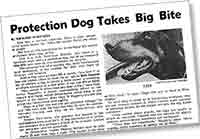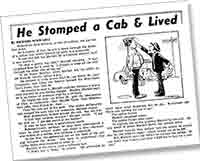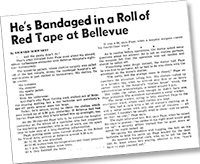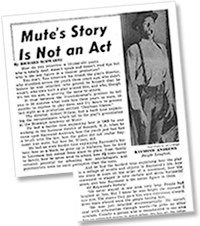
Feature Stories
East Side, West Side
New Yorkers (and their stories) are one of a kind—like the protection dog whose bark was as good as her bite, the pedestrian who kicked in the fender of a cab and lived to tell about it, the Bellevue patient who bowed out of surgery and fled in hospital garb, or the mute actor whose silence rang loud.
This is the side of New York I loved—and the New York Post was my ticket to write.
ARTICLE 
Protection Dog Takes Big Bite
By RICHARD SCHWARTZ
Liza has a nervous condition. She's a light sleeper. Little noises bother her. When her temper flares she snaps at people.
She lives at 1770 Amsterdam Av. in the Sugar Hill section of Harlem. Steer clear of her.
Liza is a 70-lb. Doberman Pinscher. Her home is a hardware store. She's a protection dog, one of an estimated 4,000-4,500 now used by city businesses for security.
The universal fear of a snarling dog, many businessmen have discovered, is one remedy for their own fears of stick-ups and break-ins
Rent-A-Dog rates go from $85 a month—"you heel it" is how one trainer refers to them—to as high as $600. Dependng on whether a dog is merely a noise maker, a watchdog, an attack specialist, or a cold killer, it can cost $75 or $4000.
"Our service is better than any Rent-A-Cop," says Capt. Arthur Haggerty, a former commarding officer in the Army's K-9 Corps whose Bronx-based rental force is the largest in the country. More than 70 Haggerty trained dogs patrol city construction sites nightly.
"Ours is a flat rate and you get unlimited mileage," he said. "We don't junk the dogs like they do cars. We provide refresher training and keep up on innoculations and bathing.'"
Trainer Tom Nova, who operates five kennels in the Metropolitan area, puts the U. S. dog population at 41 million and estimates that perhaps a milliion of the animals—trained and untrained—provide protection.
In Philadelphia, trainer Thomas McGinn says he sees nearly 25 protection dogs a week. "The market is the same as New York," he says. "Dogs bite just as hard in Philadelphia."
To teach dogs to stand up to threatening strangers, they are put through routines in which trainers make gutteral or meanacing sounds. As the trainer retreats, the dog builds confidence.
Using padded sleeve guards, the dogs are taught to attack on command. Trainers rate the animals for aggressiveness, protectiveness, sensitivity and intelligence.
"These dogs are roughheads," Haggerty jokes. "We're making useful members of society out of them."
He even thinks rehabilitating criminals—"humanizing humans," he says—would be simpler.
Haggerty, and most other dealers, will not train attack dogs for personal or home protection.
Richard Bernstein, Liza's owner, paid $1500 for the dog. She has a jaw pressure of about 100 pounds a square inch. She can snap a collarbone in a single snip. She is "attack" and "obedience" trained.
During business hours, Liza crouches behind a front counter. Above her peering eyes is a red and white sign: "Warning: This Area Patrolled by Attack Dog."
There is no sign on the front window to ward off night intruders. Bernstein prefers a burglar's acquaintance with Liza to be more spontaneous.
Bernstein, a licensed locksmith, has been robbed three times. He tried iron gates and two elaborate burglar systems for his storefront. But intruders bored their way through walls and floor.
He also invested in a $2000 ''radar" device to detect movement inside the store. But busy telephone circuits crippled the alarm relays to police.
And though Bernstein packs a pistol, he's disinclined to use it.
Not Even Attempts
In eight months with Liza and an earlier protection dog, he says, there have been no burglaries—not even attempts.
"What the dog commands that gadgets don't," says Bernstein, "is respect."
Sylvana Hirsch, owner of a bakery at 306 Columbus Av., paid $100 for a German Shepherd named Cornelius. Upkeep and care cost "much more," says Hirsch.
She said her business had been menaced by addicts and other nuisance types who "came in swinging." She bought Cornelius from trainer Haggerty after "three frightening experiences."
"A dog's an immediate danger," she says. "With an alarm, a crook could make his getaway before the police came."
Between the bakery's pie and cake displays are signs publicizing the presence of the dog. The dog is usually allowed to roam the store at will, although it is trained to attack only on command or if the owners themselves are attacked.
"It's kept away a lot of customers, particularly older women," Hirsch says. "We've lost a lot of street trade. But better that than our lives."
Hirsch, who is from Texas, believes if she were the victim of an assault onlookers would "just put their newspapers up higher over their faces."
"They'd just be happy it's not them," she says.
Phillip Goldstein, a liquor store owner down the avenue at W. 72d St., keeps a self trained Shepherd, Kelley, who "growls and backs us up."
Goldstein does not believe in posting signs. "You put up a sign, and it doesn't mean anything," he said. "They find out about the dog when they reach for the half-pints."
Goldstein, who was held up three times before purchasing Kelley, also brandishes a firearm.
'If the dog doesn't work," he said, "the pistol will."
ARTICLE 
He Stomped a Cab and Lived
By RICHARD SCHWARTZ
Pedestrian Jack Markell, no fan of cabbies, has put his foot down.
As a matter of fact, he put it down through the fender of a yellow taxi which blocked his path in a crosswalk.
It cost him $40, but Markell, 53, a financial analyst, says it was worth it.
"It was a pretty big dent," Markell chuckles. "I was surprised how far it went in. I thought it went all the way through the other side of the car."
It all began Monday, when Markell left his office at 100 Wall St. shortly before 6 p.m.
He decided to walk across Wall St., up Water St., past Chinatown, and along the Bowery toward his Stuyvesant Town home, near 14th St..
He wanted to hoof it, Markell explains, because it was a mild day and he was feeling chipper. Besides, Markell says, he is no fonder of subways than he is of taxis.
He began his trek—up Water St., past the intersection of Pine, to DePeyster, then Maiden Lane, then Fletcher, then John, then Fulton St., then . . .
Then the taxi got in his path. The cabbie deliberately had nudged his auto into the crosswalk, Markell claims.
Most pedestrians walked around the cab. But not him.
"I just kept walking straight," Markell recalls. "I put my foot up. I got $40 worth of his fender."
It was, he says now, a spontaneous revolt. Subconsciously, perhaps, he may have remembered a story he read several weeks ago about a film character who balked at a cabbie, also blocking a crosswalk.
In the film, the pedestrian sat on the hood of the cab and lectured the driver: "We have to understand that traffic lights were installed in order to . . ."
Markell, in his run-in, tried a different tact.
"I didn't say a thing," he recalls. '"He pretended he didn't know what happened, but he did. Everybody did. There was nothing for me to say."
The cabbie fumed.
Markell remained silent.
The cabbie fumed some more.
In anguish, the cabbie grabbed Markell by the suit. He was about to knock Markell down, but calmed down.
Markell says he then politely told the cabbie he would pay for the fender's repair—which turned out to be $40.
But, Markell says, not before he warned the cabbie, "If you don't take it easy, you have a $150 bill to buy me a new suit."
ARTICLE
He's Bandaged in a Roll of Red Tape at Bellevue
By RICHARD SCHWARTZ
“. . . and the pants didn't fit.”
That's what irritated John Pape most about his absurd, almost Kafkaesque encounter with Bellevue Hospital's nightime bureaucracy.
The would-be patient, whose elective surgery was called off at the last minute, thinks the municipal hospital's administration is just clothed in bureaucracy. His clothes. To be exact:
His trousers.
His sweater.
His sports jacket.
His boots.
Even his underwear.
And that's why Pape, fuming mad, stalked out of Bellevue wearing nothing but a red bathrobe and somebody's castoff pants several sizes too large.
Today, he'll return, trying to claim the clothes which were locked up at 4:30 p.m. yesterday. If Bellevue had had Its way, Pape says, they'd have locked him up overnight, too.
As the 38 year-old Pape tells it, he entered the hospital yesterday on the advice of a specialist who had suggested the marketing researcher, who is out of work, use the spare time to take care of a long-standing inflammation.
Pape, putting aside some current studies at the School for Visual Arts, arrived at Bellevue around 9:30 a.m.
At 11:30, he was admitted.
At 11:40, nurses took his temperature and blood pressure.
At 1 p.m. they began some tests.
At 4, they finished the tests.
It was 4 30, says Pape, when a hospital surgeon visited his fourth-floor ward.
As is routine before operations, the doctor asked some questions about his ailment. As is not so routine perhaps, the surgeon felt that the operation was not needed and should be called off.
Prescribing some drugs instead, the doctor told Pape he was free to go home. All he had to do was check with the attendant at the nurse's station.
"I'm sorry, but the storage room is closed," Pape remembers the attendant telling him. His clothes—rolled up in a laundry bag when he arrived only five or so hours earlier—were in the hospital's "clothes house" which, the administration acknowledges, is locked around 5 p.m.
Hot under the collar, even though he didn't have one, Pape protested. The attendant summoned a social worker.
The social worker, trying to help, escorted Pape to the emergency ward, where used clothes are kept.
"She had a rack with a lot of women's clothing on it and a metal locker with only one pair of trousers all wrinkled. I wouldn't be caught dead in them—and no socks, no shirt, no coat," Pape says.
The sight infuriated him. But, says Pape, when he raised his voice to protest—"no cabbie in his right mind would pick me up"—a security officer warned him to quiet down or spend the night locked up.
Shrugging his shoulders and tugging the belt on his bathrobe to hold his pants up, Pape headed for the door.
He ignored a hospital clerk who, as he left for the E. 10th St. hotel where he's staying, shouted to him, "You'll have to sign yourself out."
ARTICLE

Mute's Story is Not an Act
By RICHARD SCHWARTZ
How do you interview a 15-year-old youth who is totally deaf, doesn't speak and doesn't read lips but who is the key figure in a theater production?
You don't. You interview his friend, the play's director, who stumbled across the youth three years ago, who didn't believe he was retarded, who proved to himself that he wasn't, who then built a play around him, and who, though it's not his aim, is proving the same to others.
It thus becomes the friend-director's problem to tell you in 30 minutes what took him three years to learn, 18 months to express in play form and 2½ hours to present last night as a production entitled “Deafman Glance.”
The director, Robert Wilson, had a hard time explaining the circumstances which led to the play's presentation at the Brooklyn Academy of Music.
He had a harder time explaining how he was walking in the business district of Summit, N.J., when he came upon Raymond Andrews, how the youth just had had a brush with the law, how the police did not realize Raymond was mute, but how he, Wilson, did.
He had an even harder time explaining Raymond's history, how as a black, he grew up in Alabama, how he lived in Louisiana but moved from place to place, from family to family, how he never went to school, how IQ tests never revealed potential for schooling, how psychologists and psychiatrists were no more perceptive than the tests.
And he had the hardest time explaining how the play is a collage of events and objects in Raymond's life, how the story is more on the order of a movement, how the movement is staged in nine vertical and seven horizontal zones, and how Raymond is the central figure in them.
Of Raymond's history: “He never stayed in one area very long. People had laughed at him. But I knew he was bright the moment I saw him The exams they gave him were ridiculous, absurd. Even more absurd were the people testing him.
'He was just retarded environmentally. He doesn't deal with information through words—he picks up other symbols. Usually a person who is maladjusted in one area has an extended range in some other. He has all the information any kid his age should have—in fact he has a little more.”
Of their meeting: “He came to New Jersey three years ago and we met on the street. He was in trouble. He had thrown a brick through a church window. Maybe this should be off the record. This was an urban city and he's from the rural South.
“I took him to a painting class of mine and he quickly became the most active of the kids. We were exploring methods of rebuilding structures and painting them—houses, snow, tires.
Of the play: “What I'm personally concerned with is movement, developing consciousness and sensitizing the body. In the 2Oth century so much information is coming from the outside that it cuts off experience. But we know through history that the way to develop man's mind is through man's body.
“The play is a series of images linked together, a collage. If I structure it in the right way, people don't have to be anything but what they are naturally.
“In this, Raymond probably understands that he's better than anyone.”
